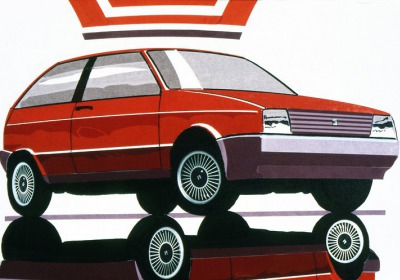30 years of Seat Ibiza, yet the design compromises sound familiar
Fri, 01 Aug 2014Over four model generations and thirty years, the Seat Ibiza's design has been overseen by some influential people; Giorgetto Giugiaro, Walter de Silva and Luc Donckerwolke shaped the Ibizas of the past, while the facelift of the most-recent model is the first to receive input from current Seat design director, Alejandro Mesonero-Romanos.
Volkswagen has been the majority shareholder of Seat since 1986, taking full control in 1990. In that time, despite the designers who have passed through its doors, the brand has struggled to find its position within the Group. Unlike Skoda, which quickly secured its niche as a value and practicality-focused alternative to Volkswagen, it has taken until the launch of the most recent Leon for Seat to become the budget-conscious Audi alternative it should have been long ago.
The Ibiza is Seat's best-selling car, and the original was born from Giugiaro's rejected proposal for the second-generation VW Golf. The Italian designer appeared on video at the event CDN attended held at Seat's design center in Martorell, to mark the Ibiza's 30th year.
"Designing the first Ibiza was all about keeping costs down," says Giugiaro. "So we took a simple approach in order to achieve maximum distinctiveness. We had to work around a heavy chassis [carried over from the Seat Ronda, which was, in turn derived from the Fiat Ritmo] but the Ibiza's proportions are still strong.
"The car has an architectural feel, with its horizontal lines, big glass surfaces, and integrated tailgate, and it benefits from a simplicity of composition that makes it still look good to this day; aesthetics are the mysterious pleasure that leads to purchase."
There's similarity between the gestation of the original car and the forthcoming Ibiza 5, due in 2017, says Mesonero-Romanos: "Seat is not an easy brand, it has always had to fight to exist, but that means it's a passionate brand, too, and that's what keeps us moving.
"Doing the Ibiza 5 is an opportunity to redesign a [VW Group] icon. I have some history with this car, as my first car was a 1987 first-generation Ibiza. In terms of design themes for the new one, I'm focusing on purity of line and a return to strong horizontality."
The Ibiza has a history of being the first to receive the VW Group's B-segment car platforms, and the fifth-generation model will be among the first the use the smaller version of the MQB modular architecture. But, as with the original model, there are still compromises to be made between the car's engineering and its design.
"The MQB has its strengths and its weaknesses," says Mesonero-Romanos. "In normal respects it's a good thing – the generic proportions it allows are better than what we have now, and it does gives us a good level of freedom with the design – I have no problem with it.
"However, the issue is when I want to do something really sporty that affects roominess, like if I want to do a really fast A-pillar, the engineers say no because the dimension it allows when you get in the car reduces the head clearance by five millimeters. My biggest fight with the engineers is currently the dimension between the base of the rear glass and the outer edge of the rear wheel. There's usually a limit of 90mm difference between the two, as otherwise shoulder-room in the rear is affected, but increasing this is a great benefit to a sportier look.
"The loading height at the rear is another one. I want a big, thick bumper and a thin boot - the Alfa Romeo Brera was particularly extreme in this regard – to give a sporty look at the back, but the engineers are reluctant as it increases the height that people have to lift their shopping bags."
Mesonero-Romano concludes by saying: "A lot of my time is spent working on convincing people that the design is important. While those practical considerations are important, I think the design has a greater impact in getting people to buy the car in the first place."
The latter statement is striking similar to Giugiaro's earlier point about aesthetics, and fittingly on-brand since VW Group has owned Italdesign since 2010. While the VW Group may not have got Seat right for some years, its persistence is impressive. However, the uplift in sales does appear in-part derived from Seat being steered towards the increasingly pervasive homogeneity in design of VW Group models, albeit not without reason as that particular aesthetic seems to have resonated with European buyers through the recent recession.
For Seat to truly stand out amongst its peers, one has to hope that Mesonero-Romano is able to convince more people of the worth of developing a design direction that's more visually arresting while still being commercially successful. That direction will also need to offer more depth than just styling around the predetermined limits of the MQB, too, although the task of getting your own way against the will of the VW Group means the toughest fights could be yet to come.
Related articles:
Designer Interviews: Luc Donckerwolke, Bentley director of design
Designer Interviews: Alejandro Mesonero-Romano, Seat director of design
By Tom Phillips



